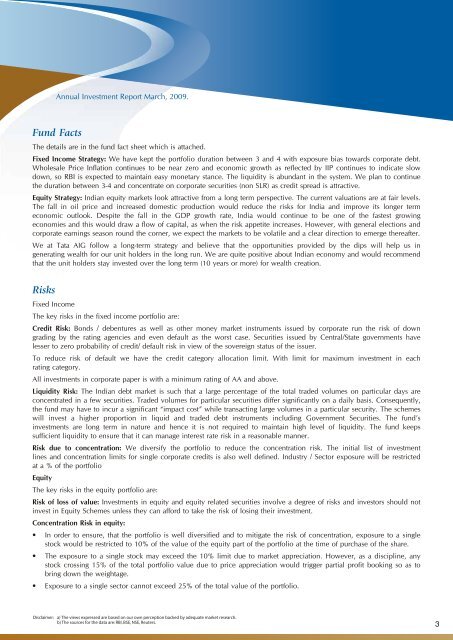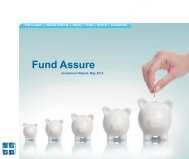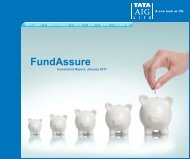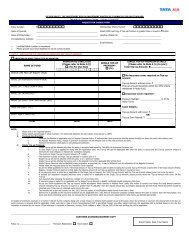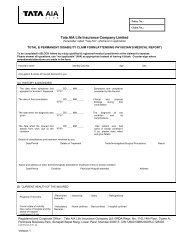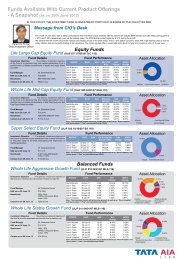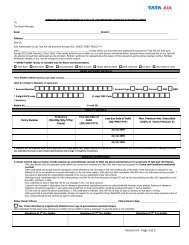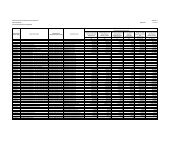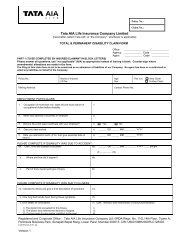<strong>Annual</strong> Investment Report <strong>Mar</strong>ch, 2009.(ii)buyback of securities issued under the MSS,(iii) amending the MoU on MSS in February 2009, allowing transfer from the MSS cash account to the normal cashaccount of the Government of India for financing of fiscal deficit, and(iv) purchase of government securities from the secondary marketYields in the government securities market hardened during the 1st half on account of the heightened inflationaryexpectations in the face of sharp increase in global commodity prices and monetary policy responses – hikes in the CRRand the LAF repo rate. Yield reached the peak in September 2008 as liquidity conditions tightened in the wake of adversedevelopments in the international financial markets and advance tax outflows. Thereafter as a result sharp decline inWPI inflation along with easy monetary policy, the yields eased substantially till end-December 2008. The 10-year yieldstood at 5.31 per cent as at end-December 2008, as compared with 8.63 per cent as at end-September 2008 and 7.93 percent as at end-<strong>Mar</strong>ch 2008. <strong>Mar</strong>ket sentiment worsened in the last quarter following the large and abrupt increase in theGovernment’s market borrowing programme for 2008-09, at a time when the system had excess SLR investment amountingto around Rs.1,79,000 crore. The ten-year yield stood at 7.01 per cent as at end-<strong>Mar</strong>ch 2009.During 2008-09, the yield on 5-year AAA-rated corporate bonds, witnessed a hardening trend up to October 2008 andbegan to soften thereafter. The yield has been inching up again since February 2009. The spread was 179 basis points on<strong>Mar</strong>ch 31, 2009 as compared to 312 basis points on December 31, 2008.Equity <strong>Mar</strong>ketsThe year 2008-09 continued to be a dismal year for the stock markets. As a reflection of the economic and financial marketoutlook, the year was characterized by depressed equity valuations. Equity price indices in most advanced economies wererelatively flat during July and August 2008, but caught on the downward spiral subsequently. Beginning mid-September2008, the Indian financial markets came under pressure owing to the knock-on effects of the global crisis through themonetary, financial, real and confidence channels. Though emerging market economies, including India, do not have director significant exposure to stressed financial instruments or troubled financial institutions, they are not immune to theadverse effects of the financial crisis. With sharp tightening of global liquidity, Indian banks and corporate saw theiroverseas financing drying up. The losses continued during the first two months of 2009 were mainly due to the downwardtrend in international equity markets on account of more than expected contraction of economic growth in the US, the UK,Japan and China pointing towards deepening of recession. Other factors that led to weak equity markets were heavy netsales by FIIs in the Indian equity market, slowdown in industrial and export growth, depreciation of the rupee against theUS dollar, fall in ADR prices, lower than expected corporate earnings in the third quarter of 2008-09, revelations aboutfinancial irregularities in a particular information technology company and other sector and stock specific news.In line with the behaviour of equity markets across the world, the Indian stock markets have been showing improvementsince <strong>Mar</strong>ch 2009. The reasons for the improvement are announcement of the details of US$ 1 trillion public privateinvestment program by the US Treasury, some major US banks posting profits for the first two months of 2009, extention ofthe deadline for buyback of foreign currency convertible bonds (FCCBs) by the Reserve Bank to December 31, 2009,domestic consumer durable and capital goods output improving since January 2009, lower domestic inflation rate,strengthening of the rupee against the US dollar and net purchases by FIIs and mutual funds in domestic equity market.The BSE Sensex and the S&P CNX Nifty closed at 9709 and 3021 at end-<strong>Mar</strong>ch 2009 registering losses of 37.9 per centand 36.2 per cent, respectively, over end-<strong>Mar</strong>ch 2008Sectoral performance: Most of the sectors witnessed sharp selling pressures during the year. The sectors like metal,consumer durables, capital goods and banking underperformed the sensex with the first three sectors falling more than55%. The other sectors also fell but outperformed the broader indices mainly IT, oil and gas, auto, public sectorundertakings, healthcare and fast moving consumer goods sectorInstitutional volumes: Institutional volumes played an important role in determining market direction. V.61 According to thedata released by the Securities and Exchange Board of India (SEBI), FIIs made net sales of Rs.48,249 crore (US $ 12.0billion) in the Indian equity market during 2008-09 as against net purchases of Rs.52,574 crore (US $ 12.7 billion) during2007-08. Mutual funds, on the other hand, made net purchases of Rs.6,985 crore during 2008-09 as compared with netpurchases of Rs.15,775 crore in the previous year. The Indian equity markets have to a large extent has also beensupported by the flows from the <strong>Insurance</strong> companies.2
<strong>Annual</strong> Investment Report <strong>Mar</strong>ch, 2009.<strong>Fund</strong> FactsThe details are in the fund fact sheet which is attached.Fixed Income Strategy: We have kept the portfolio duration between 3 and 4 with exposure bias towards corporate debt.Wholesale Price Inflation continues to be near zero and economic growth as reflected by IIP continues to indicate slowdown, so RBI is expected to maintain easy monetary stance. The liquidity is abundant in the system. We plan to continuethe duration between 3-4 and concentrate on corporate securities (non SLR) as credit spread is attractive.Equity Strategy: Indian equity markets look attractive from a long term perspective. The current valuations are at fair levels.The fall in oil price and increased domestic production would reduce the risks for India and improve its longer termeconomic outlook. Despite the fall in the GDP growth rate, India would continue to be one of the fastest growingeconomies and this would draw a flow of capital, as when the risk appetite increases. However, with general elections andcorporate earnings season round the corner, we expect the markets to be volatile and a clear direction to emerge thereafter.We at <strong>Tata</strong> AIG follow a long-term strategy and believe that the opportunities provided by the dips will help us ingenerating wealth for our unit holders in the long run. We are quite positive about Indian economy and would recommendthat the unit holders stay invested over the long term (10 years or more) for wealth creation.RisksFixed IncomeThe key risks in the fixed income portfolio are:Credit Risk: Bonds / debentures as well as other money market instruments issued by corporate run the risk of downgrading by the rating agencies and even default as the worst case. Securities issued by Central/State governments havelesser to zero probability of credit/ default risk in view of the sovereign status of the issuer.To reduce risk of default we have the credit category allocation limit. With limit for maximum investment in eachrating category.All investments in corporate paper is with a minimum rating of AA and above.Liquidity Risk: The Indian debt market is such that a large percentage of the total traded volumes on particular days areconcentrated in a few securities. Traded volumes for particular securities differ significantly on a daily basis. Consequently,the fund may have to incur a significant “impact cost” while transacting large volumes in a particular security. The schemeswill invest a higher proportion in liquid and traded debt instruments including Government Securities. The fund’sinvestments are long term in nature and hence it is not required to maintain high level of liquidity. The fund keepssufficient liquidity to ensure that it can manage interest rate risk in a reasonable manner.Risk due to concentration: We diversify the portfolio to reduce the concentration risk. The initial list of investmentlines and concentration limits for single corporate credits is also well defined. Industry / Sector exposure will be restrictedat a % of the portfolioEquityThe key risks in the equity portfolio are:Risk of loss of value: Investments in equity and equity related securities involve a degree of risks and investors should notinvest in Equity Schemes unless they can afford to take the risk of losing their investment.Concentration Risk in equity:• In order to ensure, that the portfolio is well diversified and to mitigate the risk of concentration, exposure to a singlestock would be restricted to 10% of the value of the equity part of the portfolio at the time of purchase of the share.• The exposure to a single stock may exceed the 10% limit due to market appreciation. However, as a discipline, anystock crossing 15% of the total portfolio value due to price appreciation would trigger partial profit booking so as tobring down the weightage.• Exposure to a single sector cannot exceed 25% of the total value of the portfolio.Disclaimer: a) The views expressed are based on our own perception backed by adequate market research.b) The sources for the data are: RBI, BSE, NSE, Reuters.3


